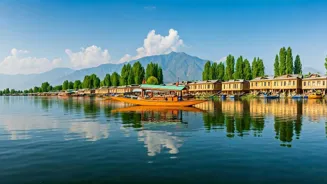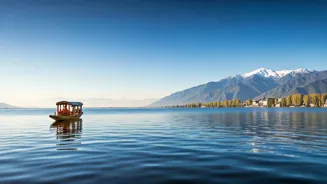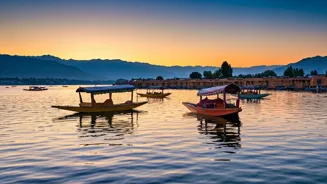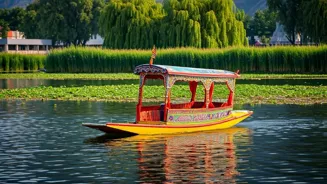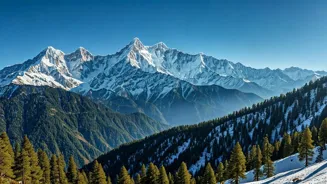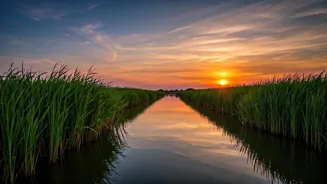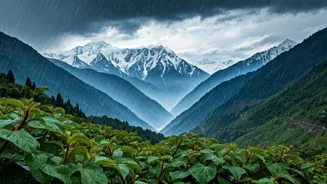Introduction to Dal
Dal Lake, often hailed as the 'Jewel in the crown of Kashmir,' is a stunning example of natural beauty found in Srinagar. The lake, encompassing several
interconnected basins, presents a picture-perfect view with its surrounding mountain ranges. Its waters reflect the changing hues of the sky, and its tranquil environment is interrupted only by the gentle movement of Shikaras (traditional wooden boats), adding to its allure. The lake’s popularity has also led to its increased exposure to threats like pollution, making it a focal point for conservation efforts. The lake is not merely a body of water, but a vital part of Srinagar's cultural fabric, attracting tourists and locals alike.
Unique Features
Dal Lake is characterized by several unique aspects. One of its most distinctive features is the 'floating gardens,' known as 'Rad' in Kashmiri, where vegetables and flowers are cultivated. These gardens float on the lake's surface, anchored by a network of reeds. Moreover, the lake is home to numerous houseboats, or 'Shikaras,' which offer accommodation and sightseeing opportunities. These boats add a distinctive visual element, reflecting the traditional lifestyle of the region. The lake's ecosystem also includes various species of aquatic plants and wildlife, contributing to its biodiversity. These elements combine to create a unique landscape that has made Dal Lake a popular destination for travelers worldwide, offering a glimpse into Kashmir’s heritage.
Life on the Lake
Dal Lake supports a bustling community with its own distinct way of life. The lake is home to fishermen who practice traditional fishing methods, adding to the lake's cultural richness. The local community also engages in various trade and commerce activities, including the sale of handicrafts, flowers, and vegetables. The 'Shikara' boats are central to this economy, providing transportation and serving as shops and homes. The lake's ecosystem also affects the lives of those living on its edges. While it provides a means of living, it also presents challenges, such as the need to manage waste and ensure the lake’s cleanliness. The livelihoods of residents depend on the lake, and they contribute to preserving the lake’s unique character.
Tourism and Economy
Tourism plays a major role in the economy of Dal Lake. The scenic beauty of the lake and its cultural significance attract a large number of tourists annually. Houseboats and Shikaras offer accommodation and sightseeing opportunities, boosting local businesses. Furthermore, tourism has created employment opportunities, from guides and boatmen to those involved in hospitality services. However, the influx of tourists has also presented challenges, like increasing pollution and the need for sustainable tourism practices to protect the lake's delicate ecosystem. Balancing economic benefits with environmental protection is crucial for the long-term sustainability of the tourism sector. The local economy depends on the flow of tourists and the preservation of the lake's natural resources.
Environmental Challenges
Dal Lake faces several environmental challenges, including pollution, habitat degradation, and the spread of invasive species. Sewage and waste disposal from nearby communities and houseboats have polluted the lake, harming its ecosystem. The lake's water quality is affected by excessive nutrient loading, leading to the rapid growth of algae and the decline of water clarity. Moreover, the encroachment of land and construction near the lake have led to habitat loss. There are a number of efforts undertaken to deal with these issues. The local government has implemented initiatives like lake cleaning programs and sewage treatment facilities. Public awareness campaigns are essential for preventing pollution and promoting sustainability. Addressing these challenges is key to ensuring the long-term health and beauty of Dal Lake.
Conservation Efforts
Various initiatives are underway to preserve and protect Dal Lake. These include cleaning operations and waste management programs intended to control pollution levels. Regular desilting operations are aimed at removing sediments and restoring the lake's depth. Public awareness campaigns play a vital role in educating locals and tourists about environmental responsibility and sustainable practices. The implementation of eco-friendly measures, such as the use of renewable energy sources and sustainable tourism practices, is also being encouraged. Government bodies and environmental organizations work together to monitor water quality, study the lake's ecosystem, and enforce regulations to protect it from further degradation. Ongoing preservation efforts are crucial to the lake's long-term survival.
Cultural Significance
Dal Lake is deeply embedded in the cultural heritage of Srinagar. The lake's beauty has inspired poets, artists, and writers for centuries, leading to the creation of various art forms like poetry and painting. The lake has also played a role in local festivals, traditions, and social gatherings. The houseboats and Shikaras reflect the local lifestyle, and the lake also functions as a historical site. Cultural events, such as boat races and floating markets, are held to celebrate the lake's legacy and bring the community together. The lake's significance is seen in the traditional way of life, the local art, and the community events that demonstrate Kashmir's unique cultural identity. It is more than just a scenic spot; it's a crucial element of the regional culture and history.
